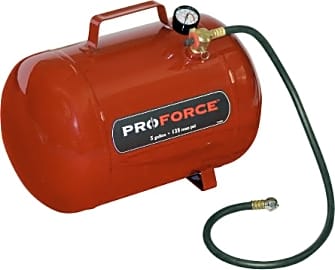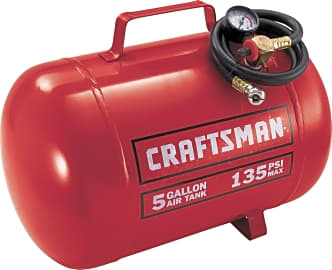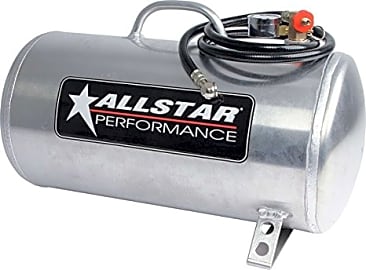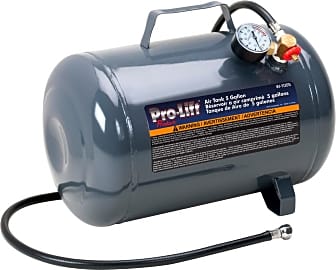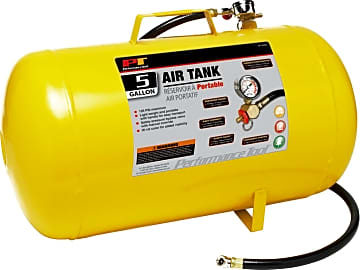The 10 Best Portable Air Tanks

This wiki has been updated 38 times since it was first published in December of 2016. Compressors are useful but tend to be big and unwieldy, which is where these portable air tanks come in. They go where you need them, helping you top up a car tire, inflate your pool toys, or even complete short tasks with your pneumatic tools. We've chosen a range of models at varying price points and capacities that should suit everyone from professional mechanics to casual home DIY enthusiasts. When users buy our independently chosen editorial choices, we may earn commissions to help fund the Wiki.
Editor's Notes
October 21, 2020:
Since these air tanks are designed to be portable, the majority of the ones we selected have a 5-gallon capacity, with the exception of the Larin AT-11, which holds 11-gallons, making it a bit more cumbersome, but allows for a greater range of uses. The Allstar Performance and the California Air Tools AUX10 come in several sizes with the latter being available in a steel or a lightweight aluminum version. They are primarily designed to be filled with an air compressor then carried to wherever the air is needed. Generally speaking, a 5-gallon tank will not hold enough air to fully inflate a flat car tire, however, they are useful for topping up the pressure, inflating bicycle tires or pool toys, or for using pneumatic tools for a short period of time.
In our latest edit, we included the new Metabo HPT UA3810AB due to its versatile design, which allows it to be used as a portable tank, or thanks to its five outlets, as a booster vessel for maintaining pressure over long distances. The Allstar Performance and the Jegs 81001 are both made from aluminum, making them up to 50 percent lighter than their steel counterparts, and therefore a good choice for lifting in and out of vehicles. Those looking for a truly portable option for small tasks such as inflating a football or a bicycle tire, may want to consider the SKS RideAir. It is small enough to fit in a bottle cage and features an unobtrusive pressure gauge.
May 10, 2019:
It has currently become difficult to find the Hyundai HHT5GAT, so we decided to remove it, but there remain plenty of worthy options. These still include the California Air Tools AUX10 and the Larin AT-11. The California Air Tools model is particularly useful, as it comes in either steel or aluminum and in 5- or 10-gallon sizes. This flexibility ensures you can choose exactly the right model for your particular shop or home. We also added the Longacre Lightweight on the strength of its inlet valve that's designed for speed. It'll probably only realistically save you a few minutes with each fill, but if you're working in an environment where speed is critical, it adds up. Finally, after some debate, we have elected to keep the Pro-Lift W-1005. Its main issue stems from the included hose and chuck, but it's also one of - if not the - lowest priced options. Plus, it is a horizontal/vertical model. These benefits may, for some, outweigh any issues caused by the hose or fittings.
Special Honors
Airpress Often the hoses, valves, and couplings that are supplied with air compressors and tanks can be sub-par, and may wear out or malfunction over time. For true peace of mind, you may consider upgrading these parts to ensure your equipment is functioning correctly and will provide reliability when you need it. airpress.net
Air Storage On A Small Scale
The most common PSI ratings for these tools range between 125 and 150 PSI.
Regardless of whether you need to blow-clean a workstation, inflate sports equipment and toys, or perform emergency tire repair when you get stuck on the road, accomplishing any one of these tasks would be rather difficult if you were completely dependent upon the use of an air compressor to help get the job done. The good news is that a portable air tank can make these tasks a lot easier, thanks to a steady supply of compressed oxygen that is stored in a compact space and ready for use at a moment's notice.
Designed for travel and use in garage or workshop environments, a portable air tank is a lightweight tool that facilitates the convenient transport of a finite volume of compressed air to a remote location. The tank offers a variety of applications, including the inflation of tires on bikes, automobiles, trailers, and all-terrain vehicles. The tank can also connect to nail guns, paint guns, and many other air tools, or it can be used to supplement the capacity of an air compressor itself. Although it does need to be filled at a gas station, one of the tank's major benefits is that it doesn't require any electrical, gas, or diesel power to operate in the field. That being said, when the tank is used to increase the available air capacity of a currently-existing compressor, it will help to ensure consistent pressure levels at all times.
Several components common to the portable air tank include a fill valve, which connects directly to a compressor; a shutoff valve, designed to prevent air from leaking out of the tank when it's not in use; a gauge, providing a user with the tank's level of internal pressure; a flexible hose attachment, used to transfer compressed air from the tank to an object; and a universal or quick-connect fitting, engineered to accommodate different hose types when on the job.
Portable air tanks carry a maximum pressure rating measured in pounds per square inch (PSI). The most common PSI ratings for these tools range between 125 and 150 PSI. However, it's important not to fill the tanks to their maximum pressure levels, particularly if they're going to be left in the sun for an extended period of time. As the ambient temperature rises, air pressure inside an air tank will also increase, risking a rupture of its outer casing.
Portable air tanks come in several sizes, with capacities measured in terms of gallons of compressed air. The most common sizes are five, seven, nine, ten, and 11 gallons. Large-capacity tanks are ideal for road trips when they may be needed to supply air to several automobile tires at once. By contrast, smaller tanks in the five-to-seven gallon range are a bit easier to store and excellent for filling up inflatable sports equipment or for "powering" an air tool for short periods of time.
Keeping The Pressure Constant
Durability and ease of transport are two extremely important considerations to make when purchasing a portable air tank for your traveling needs. The exterior body of the tank should be constructed from either steel or aluminum with sturdy brass fittings to ensure secure hose connections. A welded carrying handle with a rubber grip will also provide for easy and efficient transportation to a variety of locations.
The last thing you want during a roadside emergency is to have to fiddle with a bulky tank that's difficult to move.
We've already discussed the potential dangers associated with filling your air tank to its maximum pressure level, particularly when leaving it outdoors. But if you do have to leave it outside for any length of time, definitely spring for an option with a rust-resistant finish so it can withstand the elements.
If possible, look for a model that can be used and stored both vertically and horizontally. Doing so can help simplify the process of working in tight spaces, while also adding to the tank's versatility when being forced to move around and fill several automobile tires. The last thing you want during a roadside emergency is to have to fiddle with a bulky tank that's difficult to move. Additionally, an extra-long hose attachment will improve the tank's range of maneuverability.
Finally, make sure the unit you choose is equipped with a reliable pressure gauge, which can be a good indicator for identifying potential leaks from the tank if you notice its output beginning to falter.
A Brief History Of Portable Air Tanks
While the modern portable air tank doesn't have a definitive list of inventors attached to its identity, the tool does owe a large part of its existence to the development of the air compressor, without which it couldn't do its job properly. The earliest air compressors were the human lungs of our earliest ancestors. Lungs are capable of generating around 14.5 PSI of pressure. While that may have been enough to stoke campfires, the amount of pressure generated was inadequate to provide the heat necessary for early applications of ancient metallurgy around 3000 B.C.E.
Lungs are capable of generating around 14.5 PSI of pressure.
The first mechanical air compressor was the hand-operated bellows, followed by a foot-operated model in 1500 B.C.E.
It wasn't until the beginning of the 19th century, when metal manufacturing plants became more common and emphasized the limited power of steam, that compressed air was used to transmit energy. Compressed air was later utilized to increase industrial drilling efficiency as early as 1861, the results of which were seen in the construction of the Mont Cenis Tunnel in the Swiss Alps.
Both electricity and pneumatic energy were eventually integrated into the design of the air compressor, leading to the development of pneumatic tubing and the use of common air tools by the beginning of the 20th century. Over the last century, there has been a growing emphasis on the importance of personal mobility. This has helped pave the way for the modern use of self-contained air tanks that are easy to transport and capable of operating independently.


